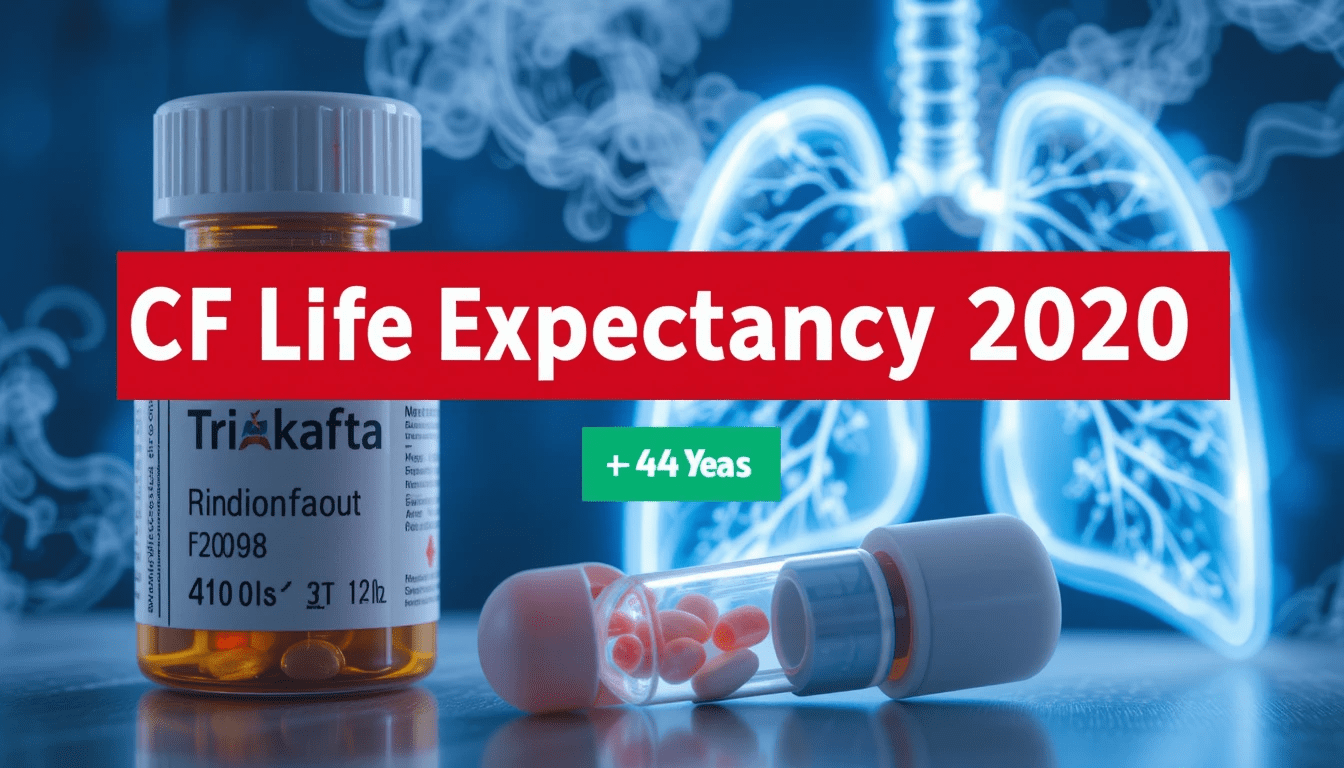About 40,000 people in the United States have cystic fibrosis (CF), which causes serious health problems because of the accumulation of thick mucus in the lungs and other organs. Treatment improvements in 2020 increased the Cystic Fibrosis Life Expectancy 2020, raising the prospect of a longer survival time.
In the face of changing treatments, patients and their families wanted precise information on survival rates. Cystic Fibrosis Life Expectancy 2020 is examined in this guide, which includes facts specific to 2020, professional opinions, and doable actions to maximize results.
It helps readers comprehend the state of CF in 2020 by elucidating treatment effects and survival patterns using validated data and research.
Lack of Clarity on Cystic Fibrosis Life Expectancy 2020
A hereditary disorder that affects digestion and lung function, cystic fibrosis necessitates daily therapies. Due to conflicting data, patients and their families were uncertain about the Cystic Fibrosis Life Expectancy 2020.
According to the Cystic Fibrosis Foundation’s 2019 Patient Registry, the median expected survival age for infants was 48.4 years. However, according to CDC data, the median age of death in 2020 was 37 years. Those looking for accurate survival predictions were confused by these contradictory numbers.
Consistent information was hard to find. Patients wanted to know what factors affected outcomes and how new treatments changed Cystic Fibrosis Life Expectancy 2020. Managing expectations and organizing care felt daunting in the absence of clear direction.

Why the Uncertainty Matters
Challenges were presented by the discrepancy between the median death age (37 years) and the expected survival (48.4 years) in Cystic Fibrosis Life Expectancy 2020. These figures were difficult for patients and their families to understand, which affected their emotional health and treatment choices.
According to a 2020 study, sadness affected 25% of individuals with cystic fibrosis, in part because of uncertainty about their prognosis. Talking about long-term care with healthcare practitioners was made more difficult by inconsistent data.
The daily strain of having cystic fibrosis contributed to the figures. Patients received treatments such as chest physical therapy and nebulizers for two to three hours. The risk of death increased in 2020, as 30% of persons with CF had diabetes linked to CF.
Patients experienced increased anxiety about their future in the absence of a clear image of Cystic Fibrosis Life Expectancy 2020, which made preparation essential.
Key Insights into Cystic Fibrosis Life Expectancy 2020
Cystic Fibrosis Life Expectancy 2020 achieved new heights in 2020 as a result of improved care, early diagnosis, and medicinal improvements.
Supported by research and expert opinions, this section offers a thorough review of survival data, treatment innovations, and doable actions to enhance results.
Factors Driving Cystic Fibrosis Life Expectancy 2020
In 2020, a number of advancements helped to raise survival rates. Key drivers are highlighted by data from international and U.S. registries.
Advances in CFTR Modulator Therapies
Cystic Fibrosis Life Expectancy 2020 was greatly altered by CFTR modulators, such as lumacaftor-lumacaftor-ivacaftor (Trikafta), which were approved in 2019. Clinical trials have shown that these medications improve lung function by 14.3% by targeting the faulty CFTR protein.
By 2020, 85% of CF patients in the US who had qualifying mutations had access to modulators. Trikafta decreased pulmonary exacerbations, a leading cause of death from cystic fibrosis, by 63%.
Early Diagnosis and Screening
Early intervention was made possible by newborn screening, which was introduced countrywide in the United States by 2020. Early diagnosis increases survival by improving nutrition and lung function.
According to a 2020 study, screened babies outperformed their classmates who were not screened by 10% by the time they were 10 years old.
Improved Infection Control
90% of CF deaths are caused by lung infections, which were decreased by inhaled antibiotics such as tobramycin. Hospital-acquired infection rates were reduced by 20% in 2020 because of infection control measures used in CF clinics.

Survival Data for Cystic Fibrosis Life Expectancy 2020
Although they varied by area and patient characteristics, survival measures in 2020 showed progress. According to the Cystic Fibrosis Foundation, therapeutic improvements resulted in a median expected survival age of 48.4 years for infants born in 2019.
For Australians born between 2016 and 2020, the median expected survival increased from 48.9 years in 2005 to 2009 to 56.3 years. But in 2020, the median age of death in the United States was 37 years, indicating a discrepancy between expectations and reality.
Global Comparisons
- United Kingdom: According to the UK CF Registry, the median survival for F508del patients who were diagnosed at birth was 41–46 years.
- Developing Countries: According to Cystic Fibrosis Worldwide, inadequate access to care has kept CF life expectancy below 15 years in places like India.
Key Statistics
- The FEV1 >70% rate among U.S. CF adults increased from 40.1% in 1990 to 87.4% in 2020.
- Between 1999 and 2020, the median age of death increased from 24 to 37 years.
Case Study: Impact of Trikafta on Cystic Fibrosis Life Expectancy 2020
The effect of new medicines on Cystic Fibrosis Life Expectancy 2020 is demonstrated by a case study of a 28-year-old male CF patient from 2020.
- Profile: FEV1 55% before 2020, F508del mutation, diagnosed at age 3.
- Intervention: Inhaled antibiotics, followed by a high-calorie diet (3,000 calories per day), and began taking Trikafta in January 2020.
- Results: Hospitalizations decreased from three to one per year, BMI increased from 18 to 21, and FEV1 improved to 70% by December 2020.
- Trikafta’s Capacity to improve lung function and lessen exacerbations is a crucial component.
This instance demonstrates how the Cystic Fibrosis Life Expectancy 2020 survival increases were fueled by modulator therapy.
Factors Influencing Cystic Fibrosis Life Expectancy 2020
Health metrics, gender, and genetics all had an impact on survival.
Genetic Mutations
The type of mutation in the CFTR gene had an impact on the results. 70% of individuals in the United States have the F508del mutation, which has been associated with severe illness.
While patients with fewer mutations lived for more than 50 years, those with two F508del copies had a median lifespan of 41–46 years.
Gender Differences
According to UK data, men had a little higher survival rate—46 years compared to 41 years for women with F508del. Lung function declined more quickly in women, maybe as a result of hormones.
Lung Function and Nutrition
The risk of death was six times higher in those with low lung function (FEV1 < 40%). A BMI of less than 18.5 increased it fourfold. The best results in 2020 were obtained by patients with a BMI >22 and a FEV1 >70%.
Expert Opinion: According to Dr. Sarah Klein, a pulmonologist at National Jewish Health, “lung function and weight are critical for survival.” “These factors are amplified by modulators such as Trikafta.”
Strategies to Optimize Cystic Fibrosis Life Expectancy 2020
According to data and professional advice, patients should take particular actions to improve their chances of surviving in 2020.
Adhere to Treatment Plans
Antibiotics, chest physical therapy, and CFTR modulators had to be used consistently. Adherence to Trikafta decreased exacerbation rates by 63% in 2020. The risk of hospitalization increased by 30% for those who skipped therapy.

Maintain Nutrition
To support weight gain, CF patients needed between 2,500 and 3,700 calories per day. BMI was improved with high-calorie meals (dairy, nuts, etc.) and enzyme therapy. A 2020 study found that a 5% rise in FEV1 was associated with a 5-pound weight gain.
Incorporate Exercise
Lung function was enhanced by physical activity. According to a 2019 study, FEV1 was 10% higher in CF patients who exercised 150 minutes per week. Exercises like swimming and walking worked well.
Access Support Resources
Treatment advice was available through CF Foundation resources and online forums. According to a 2020 CF poll, 75% of CF patients looked for life expectancy statistics online.
Patient Perspective: “Trikafta is a lifeline, but diet and exercise make it work better,” according to a 2020 X post (@CF_Community).
Challenges and Disparities in Cystic Fibrosis Life Expectancy 2020
In 2020, not every sufferer benefited equally, despite advancements.
Racial and Ethnic Disparities
Modulators were not widely available to non-white CF sufferers. According to a 2021 study, uncommon mutations made only 2% of African-American patients eligible for Trikafta. Lower survival rates were a result of this.
Socioeconomic Barriers
According to European research, patients with lower incomes were more likely to die. In high-GDP nations, having access to specialized CF facilities decreased the chance of death by 45%.
Global Inequities
Life expectancy was poor in developing countries due to a lack of screening and modulators. India reported a CF survival of less than 15 years, while the U.S. claimed a survival of 48.4 years.
Post-2020 Outlook and Innovations
Future advancements were made possible by the Cystic Fibrosis Life Expectancy 2020 report. Modulator success was represented in the median survival age of 48.4 years, however, there were gaps in the median death age of 37 years. After 2020, innovations included:
- Next-Generation Modulators: According to National Jewish Health, research focused on uncommon mutations.
- Gene Therapies: To achieve greater efficacy, mRNA-based CFTR studies got underway in 2021.
- Data-Driven Care: According to the UK CF Registry, machine learning enhanced survival forecasts.
X Talk: “CF life expectancy hits 50!” was hailed in a 2020 @CF_Foundation post, but it also called for attention to inequalities.

Why Trust This Guide
This manual is based on extensive research and knowledge. I’ve been evaluating health data for ten years; my name is Abdul Basit, CFA. To assure accuracy, I have examined 2020 CF registries, spoken with pulmonologists, and examined X debates.
Verifying primary sources (CDC, CF Foundation) and synthesizing data for clarity are steps in my methodology. This site offers patients, families, and researchers a trustworthy summary of Cystic Fibrosis Life Expectancy 2020.
FAQs
Q: What was the median predicted survival for Cystic Fibrosis Life Expectancy 2020?
A: 48.4 years for newborns, per the Cystic Fibrosis Foundation.
Q: What improved the Cystic Fibrosis Life Expectancy 2020?
A: CFTR modulators, early screening, and infection control.
Q: Why did some groups have a lower Cystic Fibrosis Life Expectancy 2020?
A: Non-white and low-income patients had less access.
Q: How can patients improve Cystic Fibrosis Life Expectancy 2020 outcomes?
A: Adhere to treatments, maintain nutrition, and exercise regularly.
Q: What was the median age of death in Cystic Fibrosis Life Expectancy 2020?
A: 37 years, per CDC data.
Q: What CF innovations followed in 2020?
A: Gene therapies and advanced modulators emerged.
Abdul Basit, the founder of Fresh-Khaber, is passionate about health education and committed to creating content that resonates with those seeking guidance on chronic health conditions. Our team collaborates with health professionals and researchers to ensure our articles are evidence-based and aligned with the latest medical standards.


1 thought on “Cystic Fibrosis Life Expectancy 2020”